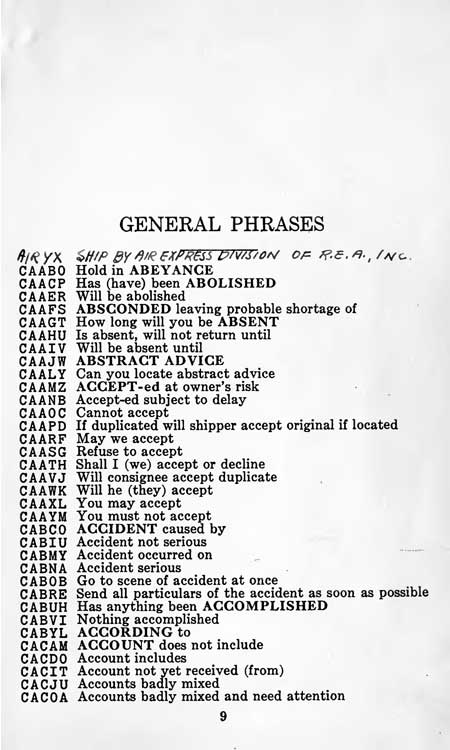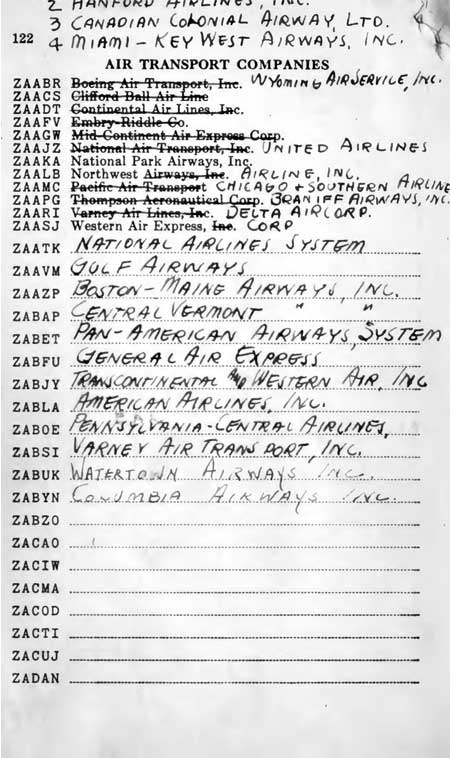telegraphic codes and message practice
scanned code directory
rail transportation
This page is another step in a redistribution (and expansion) of content in my scanned code directory project. It contains notes and selected images of codes that are entirely or primarily devoted to rail transportation. This is a work in progress.
1901 Telegraph Code F,
Grand Trunk Railway System (General Freight Department)
1906 Standard Cipher Code of the American Railway Association
1930 General Cipher Code (Railway Express Agency)
Where examples are taken from digitized scans, they are generally cropped to favor text block; no attempt is made to guess margin sizes. Some examples are taken from copies in a private collection: these will show entire page and page spreads.
intro
Railroad codes are found in two basic forms: one relating to freight and passenger operations, the other to business. Related codes exist for locomotive manufacturers, for example, and industry associations (such as the American Railway Association code of 1906.
It should go without saying that rail transportation is covered in a variety of other codes, including meat packing, produce (see the Peycke codes), travel, and even many social
codes. My main consideration in classifying codes in this way, is to distribute descriptions of the codes among several pages, rather than one, slow-loading, long one.
| 1906 | Standard Cipher Code of the American Railway Association, For the Use of All Departments of the Railway Service | The American Railway Association, New York | google Michigan HE7677.R2 A5 |
[5] vi-xvi, 1-751
index pp v-xvi
unnumbered p752 : Press of John A. Phillips, 86 Fulton St. New York
Mainly phrases, some tables
All entries are numbered, with sequences starting at 1
on each page.
From the two-page Introductory
— The initial letter of each code word corresponds with the initial letter of the general subject of the message as given in the classified headings.
Some examples, under heading Classification
at page 116 —
| 9 | Clypeolet | Commodity rate(s) governed by — classification |
| 10 | Clysmian | Emigrant movables as per — classification |
| 11 | Coachbell | Estimated weight as per — classification |
| 12 | Coachbox | Exception sheet to the — classification |
| 13 | Coachdog | Governed by — classification |
| 14 | Coached | How do you classify? |
| 15 | Coachful | How shall I classify? |
| 16 | Coachlet | I understand proper classification to be |
Numbering of code/phrase pairs facilitates secrecy, by previous arrangement
of correspondents using the code.
 |
|
| pp 749-50 (but not spread) ex Standard Cipher Code of the American Railway Association (1906) | |
A running account of the development of this code can be found in the Proceedings of the American Railway Association (April 22, 1903 to October 24, 1906, Inclusive). Various reports of the Committee on Standard Cipher Code detail progress — slow progress — with the project.
The committee examined 17 different railway-related cipher codes, and from those drew some 95,000 phrases. These were reduced to 53,000, forming the basis of future work. These phrases have been classified by departments, sections and subjects, as shown in the supplement to the report, and the material is now in shape where it is necessary to call for the services of a professional code expert to complete the work...
(March 15, 1904, p233 here)
The Committee’s report of September 12, 1904 presents the contract with the International Cable Directory Company, New York, for the production of a new code at a total cost of $3,250.
The code compiler will compile and furnish... a full and complete manuscript copy of a private cipher code; said code to be compiled under the supervision of Mr. D. G. Kendig or some other competent expert satisfactory to [ARA], and to contain in a classified arrangement the data furnished by [ARA]>i> and such other suitable and approved matter as may be available from other sources; all topics, phrases, and cipher words to be arranged in proper alphabetical seqence and the entire work to be so constructed that a marginal index will refer to both code words and subjects. The code words to be selected from the Official Vocabulary.
The compiler further agrees to have the approved manuscript set up in type, style and size of pages similar to the United States Steel Corporation Telegraphic Code, and to have the same electroplated and to furnish electroplates of all the pages ready for printing to the party of the first part at the rate of $2.50 per page.
(here).
Kendig compiled the U.S. Steel Corp Telegraphic Code (1904).
| 1930 | General Cipher Code, Railway Express Agency | New York | archive.org Duke / Gessler |
New York, November 1930
[4], 1-126
5L AAB-A-B > BUN-Z-Y (flexible); CAABO-ZAUJF
flexible phrase tables pp1-7;
general phrases start at p9;
more flexible tables (for dates, etc) at 113ff.
This copy rubber stamped 2324
on title page;
some handwritten checkmarks, additions: many on blank code pages 104-105 (geographcal locations, some phrases relating to publicity
), 122 (names of air transport companies)
including added phrase at head of p9: AIRYX / Ship by Air Express Division of R.E.A., Inc.
Some emendations dated (September 1935).
 |
 |
| pages 1, 9 (not spread), General Cipher Code, Railway Express Agency (1930) |
The first of seven pages of conventional flexible
phrase tables.
 |
 |
| pages 105, 122 (not spread), General Cipher Code, Railway Express Agency (1930) |
Express Motion Poster Service may have been an advertising firm (see US Patent 1,839,825 (1932) for a Metallic Signboard), suggesting that user of the copy of the code may have been involved in advertising, possibly for the movies.
Changes in names of airlines would seem to reflect the many changes in the industry prompted by the notorious Air Mail Act
of 1934, in which, for example, Boeing (Air Transport, Inc.) was forced to get out of the air mail business. (wikipedia)
The Railway Express Agency was a national monopoly
set up by the federal government in 1917 (wikipedia). In an earlier form (American Railway Express, Inc.), it began an air express division in 1927; the entire operation was transferred to an entity (REA) owned by 86 railroads in 1929.